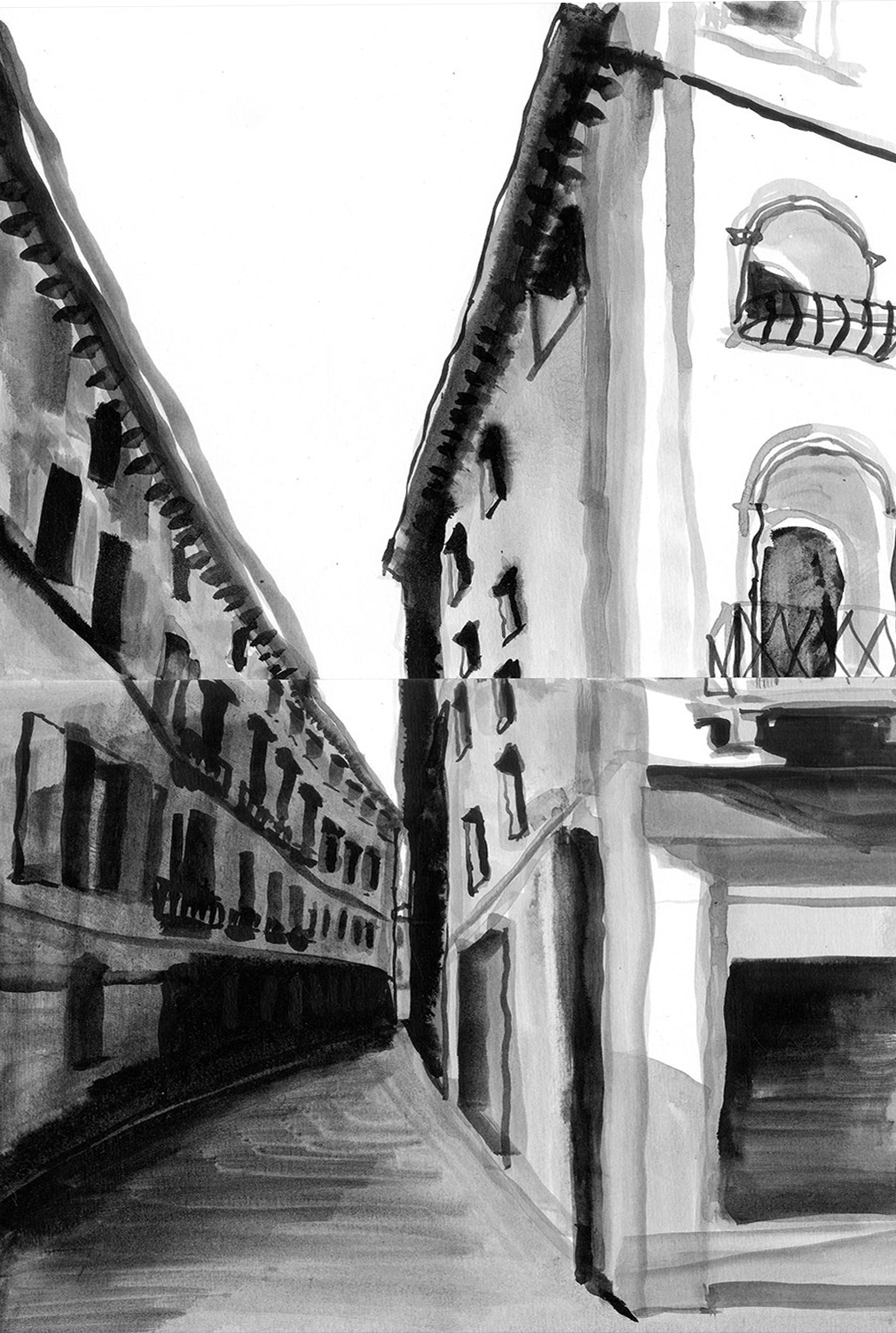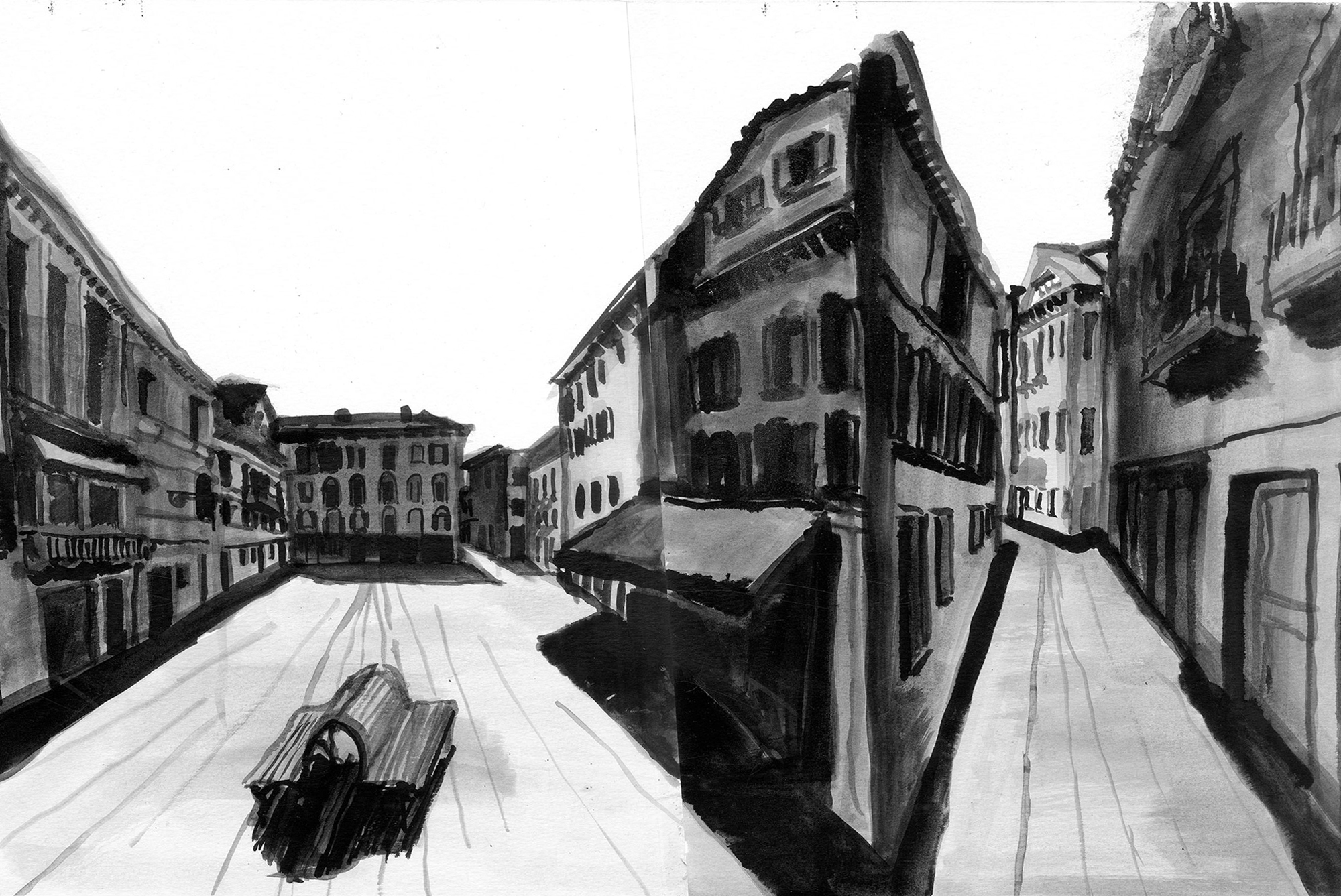Walking Venice
Cornell University Thesis (2015)
Venice, Italy

Site Plan with Narrative Pathways
Proposal: to document three sequences of space through the city of Venice
Thesis Advisors
Vince Mulcahy
Jim Williamson
The site documentation of Library in the Labyrinth, these perspective ink paintings portray three linear sequences of wandering through the fabric of Venice and become the subject of A Model of Paintings. The three pathways start in disparate neighborhoods, but ultimately all converge on one site. A fourth pathway starts at the site and proceeds along the park toward the water, out of the maze. There are no perspectives for this pathway, yet.
Each narrative begins with a summary. Each summary begins with the excerpt from one of John Hejduks 67 Victims. Each excerpt is extrapolated to become a character in Venice. They include: the Drawbridge Man, the Mask Repairman, and the Accountant. Each of these three characters are assigned to one of the three pathways. A fourth character, the Solosit, is assigned to the pathway that leaves from the site.
Related Project Pages
The Drawbridge Man

The Drawbridge Man Combined Leporello, Ink on Paper
The drawbridge man does not believe in clocks. He measure the lenght of the day by the passage of visitors. Some days are long; some days are short. Open, wait, close.When he works with the carpenter, the drawbridge man replicates the connections for their drawings. He is primarily concerned with the way things come together, and the way they used to be separate. The drawbridge man is (currently) very satisfied with connections he percieves to be permanent. Open, wait, close. The drawbridge man knows that one day the visitors will stop coming. he will then have to choose whether to leave the bridge open or closed. Open, wait, close.









The Mask Repairman

The Mask Repairman Combined Leporello, Ink on Paper
Each day, he walks a different route home from the mask shop. It might be close to the right face of the street, and tightly around the corners. It might be slowly, or very quick. Eventually, he moves on to the next street. On these routes, he has found 67 discarded or lost masks. He meticulously restores one mask per week. He becomes obsessed.
By Friday evening of each week, he has dreamed an entire personality of its past. He imagines the expressions that the mask hid. One by one, the mask repairman sells his recoeved masks. Each is laced with memory. The hidden expression are transferred ot the new face.








The Accountant

The Accountant Combined Leporello, Ink on Paper
Numbers title his memories, but they do not help to organize them. His first memory is 8; his last is 19. There are hundreds, maybe thousands in between. Sometimes he mistakes his professional accounts with the memories of his own childhood. The system is inefficient; it is imperative he maintain some order. But it does not bother him in the end; he prefers thinking in terms of past experiences than in empty numbers. The accountant uses the streets of Venice as his shelves of memory. He walks particular routes and assigns the records of past experiences to details he encounters. As he carefully learns the labyrinthian streets, he uncovers pieces of his past.









The Soloist

The solosit enjoys playing his instrument in the streets of Venice. He imagines the streetscape as a collection of connected stages. The sound of his instrument leaves him immediately and runs through the narrow streets, dances across the canals. The soloist often hears the music of others as he walks the labyrinth, though he can never see where it comes from. The stages are anonymous. The soloist comes to Venice every summer and plays for six hours each day. He plays the same song everyday. He knows the visitors can always hear several songs simultaneously as they walk the labyrinth. He is part of an orchestra. The soloist spends the last week of every summer in the park. By then, the song has replaced his thoughts. Only by escaping the labyrinth and standing amongst the trees can the soloist feel the silence again.

